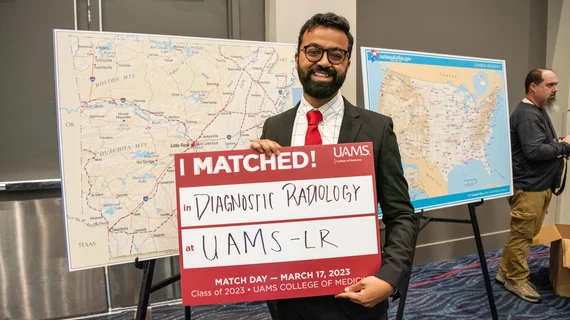New data show radiology program directors favoring this factor when selecting residents
New data show that radiology program directors are favoring a certain factor when selecting residents.
The National Resident Match Program on Aug. 20 released new details on the characteristics of U.S. MD seniors who matched into their preferred specialty in 2024. In a field as competitive as radiology, program directors are seeking objective metrics to weigh applicants.
Back in 2022, U.S. Medical Licensing Examination organizers deemphasized the importance of numerical scores on the Step 1 exam. Where leaders once used results to select candidates, now the test would shift to a pass-fail system to reduce overemphasis on these three-digit scores.
This created a “data void in the resident selection process,” said Francis Deng, MD, a radiologist, researcher and former board member for the NRMP. Radiologists expressed concern in years past that this transition would lead to program directors placing greater emphasis on Step 2 exams, and it appears as if that is coming true.
USLME Step 2 CK scores are now a “key focus of competition for residency in the U.S.,” Deng noted in a social media post. The average matched U.S. MD student’s score was 250 in Match 2024. In highly competitive specialties—such as radiology, dermatology or orthopedics—the average score was greater than 255 (diagnostic radiology’s average was 256, up from 247 in 2016).
“The focus on Step 2 CK compared to the prior focus on Step 1 means a greater importance placed on clinical knowledge,” Deng told Radiology Business by email Friday. “Step 2 CK for the most part covers content learned from clinical clerkships whereas Step 1 was focused on basic sciences learned in the preclinical curriculum. The content of Step 2 CK bears more relevance to the practice of clinical radiology, so the shift in emphasis as a residency selection factor should be welcomed as providing face validity. Moreover, Step 2 CK is taken later in medical school and represents a summative evaluation that is closer in time to residency and so should correlate moderately well with exam performance during residency. Students who have an upward trajectory in academic performance or decide somewhat late that they want to do a competitive specialty will also benefit from this change.”
Deng predicted this future trend in 2020 ahead of the Step 1 shift to pass/fail. So did the authors of a 2021 study published in the Journal of the American College of Radiology, who also anticipated that medical school prestige could gain an “outsized influence.”
Higher Step 2 scores than average among U.S. MD students who matched into radiology reflect two factors, Deng noted. Program directors are “heavily selecting” the higher scoring applicants, and applicants are self-selecting based on their competitiveness.
“The latter factor is probably smaller than it was for Step 1, as there is little time for a pivot between when a student learns their Step 2 CK score and when they have to submit residency applications,” he noted.
For those seeking to match into a radiology program, the key takeaway is “take Step 2 seriously,” Deng advised.
“The old adage for recommended preparation was ‘two months for Step 1, two weeks for Step 2 CK, a number 2 pencil for Step 3,’” he told Radiology Business. “With the new USMLE scoring system, that no longer applies. Preparation for Step 2 CK should include using spaced repetition longitudinally to maintain high retention of knowledge learned throughout the clerkship year and capping it off with more than two weeks of dedicated studying for the test.”
And for residency program directors: “A 250 score on Step 2 CK means the same thing today as it did when you were a medical student in terms of absolute medical knowledge mastery,” Deng added. “However, the relative meaning has changed significantly because students are studying harder for it. A 250 would have been above average just four years ago but is now below average among U.S. MD radiology applicants. The whole score distribution has shifted about half a standard deviation, 7 points, in that time.”
NRMP also released survey data from program directors on Aug. 8. The data show that USMLE Step 2 CK scores now surpass the personal statement among the top 5 most important factors in deciding whether to interview an applicant, Deng noted. More than two-thirds of programs now require a Step 2 CK score for interview selection, an increase and “direct consequence of the change of Step 1 to pass/fail reporting,” he added.
You can find additional data here. Deng also co-authored a Radiology study in September 2023, highlighting how that year’s residency match was the most competitive for the specialty since 2001.

